
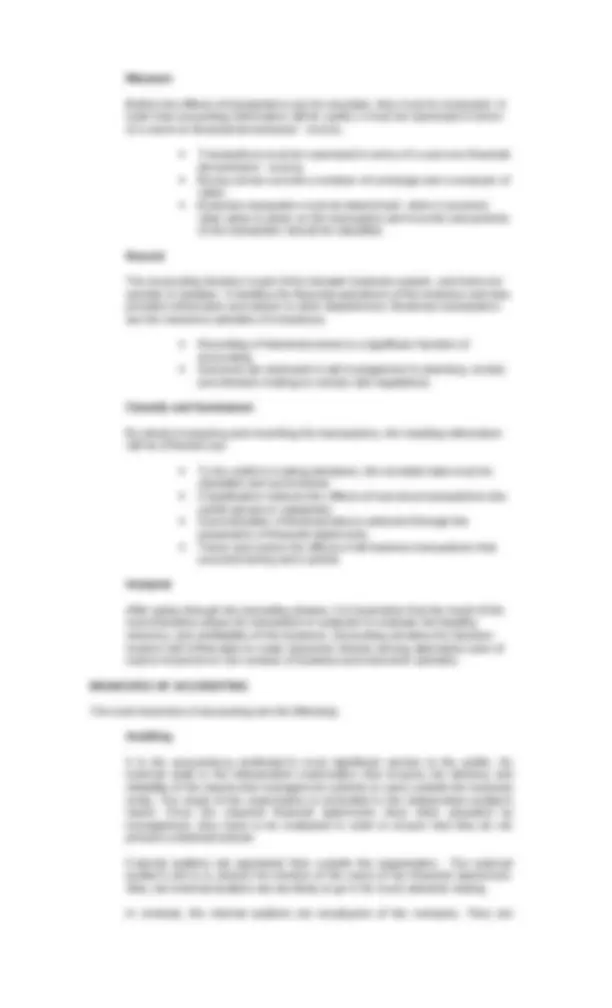
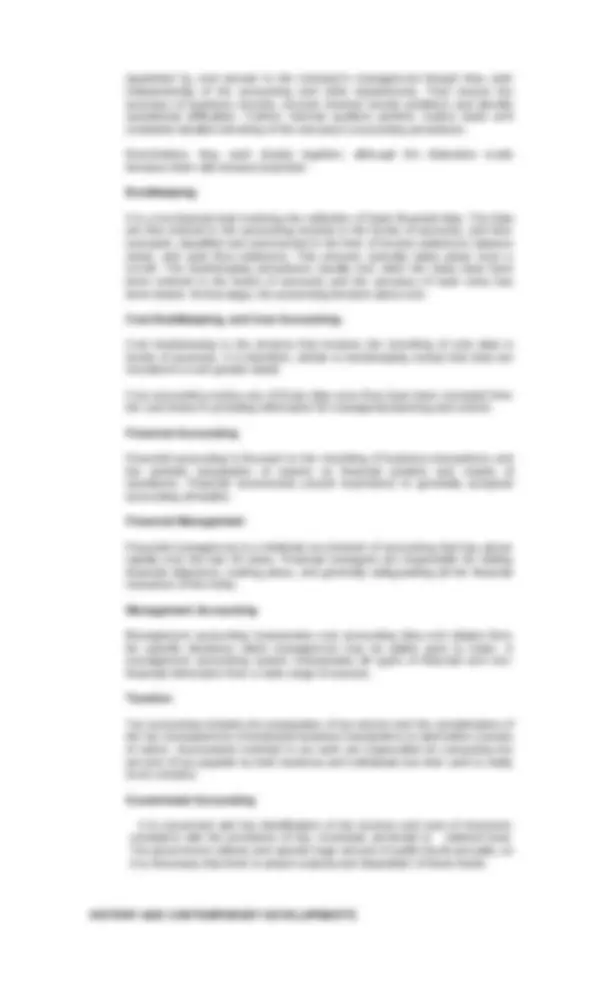
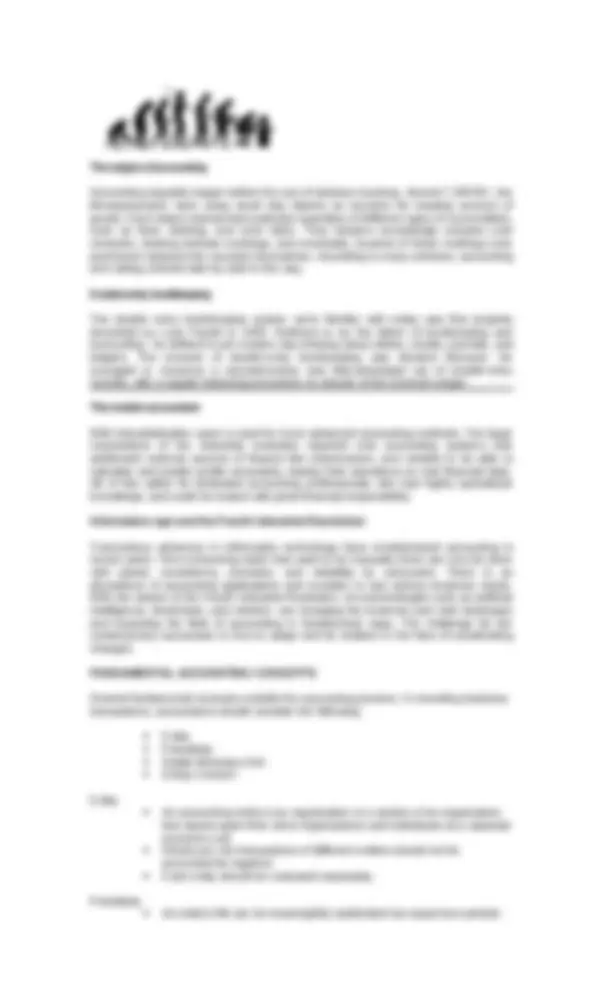
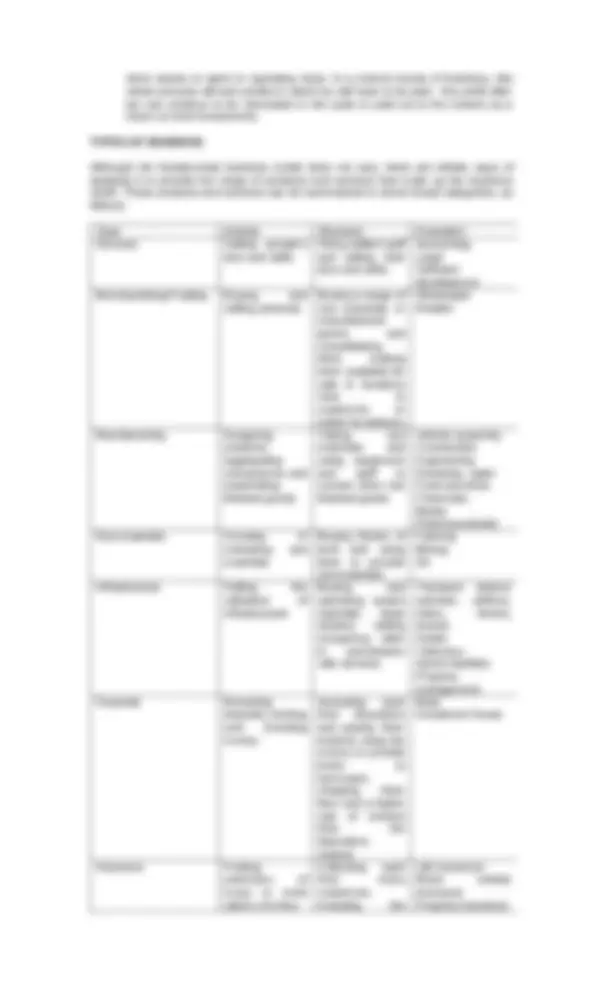
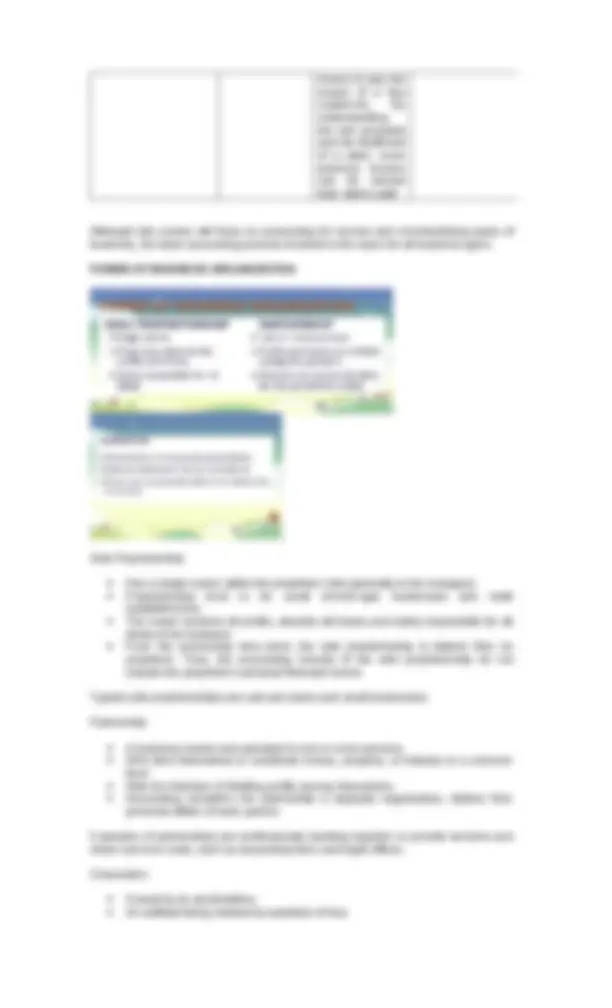
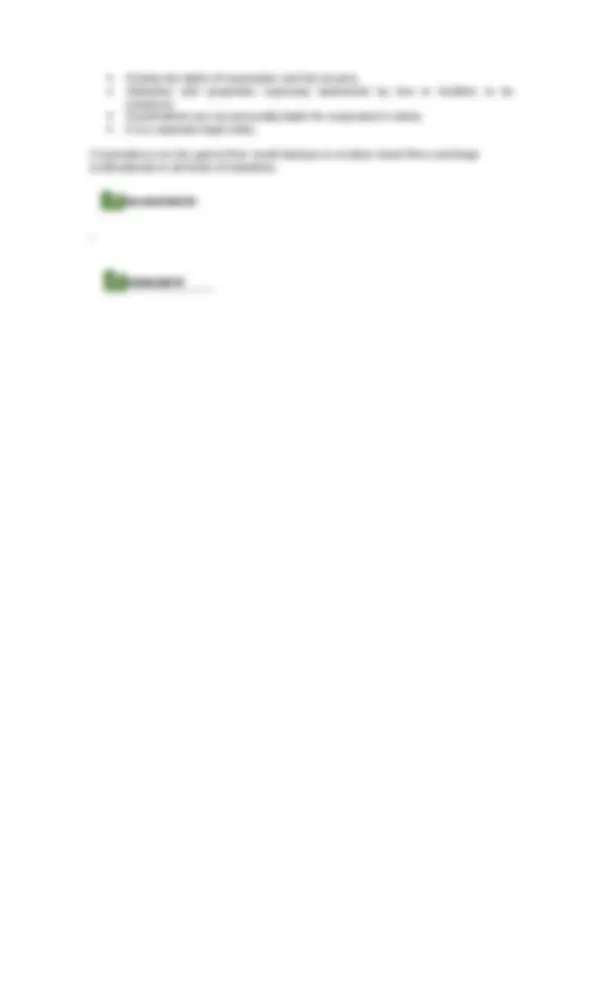


Study with the several resources on Docsity

Earn points by helping other students or get them with a premium plan


Prepare for your exams
Study with the several resources on Docsity

Earn points to download
Earn points by helping other students or get them with a premium plan
Community
Ask the community for help and clear up your study doubts
Discover the best universities in your country according to Docsity users
Free resources
Download our free guides on studying techniques, anxiety management strategies, and thesis advice from Docsity tutors
asdfghjklasdfghjklasdfghjklqazwsxedc
Typology: Study notes
Uploaded on 10/17/2020
1 document
1 / 10

This page cannot be seen from the preview
Don't miss anything!







Course instructor: Christine L. Nifras, CPA, MBA Contact details: FB messenger: Christine Nifras | Email: c.nifras@usls.edu.ph | Phone: + 9199112509, 4341530 BASIC ACCOUNTING WITH BASIC CORPORATE ACCOUNTING (ACCT 101) THE WORLD OF ACCOUNTING AND BUSINESS Accounting has evolved in response to the social and economic needs of society. As business and society becomes more complex, accounting develops new concepts and techniques to meet the ever-increasing needs for financial information. Accounting is relevant in all walks of life, and is absolutely essential in the world of business. No business could operate very long without knowing how much it was earning and how much it is spending. This module will help the students understand what accounting is, and how it has evolved. Module 1 illustrates the fundamental business model, identifies the different forms and activities of business organizations, details the importance of the purpose and phases of accounting, and presents the fundamental accounting concepts and principles. Targeted Course Outcome Demonstrate understanding of fundamental accounting concepts and principles, and the business context where accounting is applied. Course Outcomes
economic entity by observing, detecting, investigating, and identifying the economic events via established collecting, testing, analyzing and presenting methods. Accounting is the art of recording, classifying and summarizing in a significant manner and in terms of money, transactions and events which are, in part at least, of a financial character, and interpreting the results thereof. PURPOSE AND PHASES OF ACCOUNTING Measure Record Classify Summarize Interpret
appointed by, and answer to the company’s management though they work independently of the accounting and other departments. They ensure the accuracy of business records, uncover internal control problems and identify operational difficulties. Further, internal auditors perform routine tasks and undertake detailed checking of the company’s accounting procedures. Nonetheless, they work closely together, although the distinction made between them still remains important. Bookkeeping. It is a mechanical task involving the collection of basic financial data. The data are first entered in the accounting records or the books of accounts, and then extracted, classified and summarized in the form of income statement, balance sheet, and cash flow statement. This process normally takes place once a month. The bookkeeping procedures usually end when the basic data have been entered in the books of accounts and the accuracy of each entry has been tested. At that stage, the accounting function takes over. Cost Bookkeeping, and Cost Accounting. Cost bookkeeping is the process that involves the recording of cost data in books of accounts. It is therefore, similar to bookkeeping except that data are recorded in much greater detail. Cost accounting makes use of those data once they have been extracted from the cost books in providing information for managerial planning and control. Financial Accounting Financial accounting is focused on the recording of business transactions and the periodic preparation of reports on financial position and results of operations. Financial accountants accord importance to generally accepted accounting principles. Financial Management Financial management is a relatively new branch of accounting that has grown rapidly over the last 30 years. Financial managers are responsible for setting financial objectives, making plans, and generally safeguarding all the financial resources of the entity. Management Accounting Management accounting incorporates cost accounting data and adapts them for specific decisions which management may be called upon to make. A management accounting system incorporates all types of financial and non- financial information from a wide range of sources. Taxation Tax accounting includes the preparation of tax returns and the consideration of the tax consequences of proposed business transactions or alternative courses of action. Accountants involved in tax work are responsible for computing the amount of tax payable by both business and individuals but their work is really more complex. Government Accounting It is concerned with the identification of the sources and uses of resources consistent with the provisions of city, municipal, provincial or national laws. The government collects and spends huge amount of public funds annually, so it is necessary that there is proper custody and disposition of these funds. HISTORY AND CONTEMPORARY DEVELOPMENTS
The origins of accounting Accounting arguably began before the use of abstract counting. Around 7,500 BC, the Mesopotamians were using small clay objects as counters for keeping account of goods. Each object represented particular quantities of different types of commodities, such as food, clothing, and even labor. They became increasingly complex over centuries, bearing intricate markings, and eventually, imprints of these markings onto parchment replaced the counters themselves. According to many scholars, accounting and writing evolved side-by-side in this way. Double entry bookkeeping The double entry bookkeeping system we’re familiar with today was first properly described by Luca Pacioli in 1494. Referred to as ‘the father of bookkeeping and accounting’, he defined much modern day thinking about debits, credits, journals, and ledgers. The inventor of double-entry bookkeeping was Amatino Manucci. He managed to construct a comprehensive and fully-articulated set of double-entry records, with a regular balancing procedure on closure of the General Ledger. The modern accountant With industrialization came a need for more advanced accounting methods. The large corporations of the industrial revolution required cost accounting systems that addressed external sources of finance like shareowners, and needed to be able to calculate and predict profits accurately, basing their operations on real financial data. All of this called for dedicated accounting professionals who had highly specialized knowledge, and could be trusted with great financial responsibility. Information age and the Fourth Industrial Revolution Tremendous advances in information technology have revolutionized accounting in recent years. Time-consuming tasks that used to be manually done can now be done with speed, consistency, precision, and reliability by computers. There is an abundance of accounting applications and modules to suit various business needs. With the advent of the Fourth Industrial Revolution, new technologies such as artificial intelligence, blockchain, and robotics are changing the business and work landscape and impacting the field of accounting in fundamental ways. The challenge for the contemporary accountant is how to adapt and be resilient in the face of accelerating changes. FUNDAMENTAL ACCOUNTING CONCEPTS Several fundamental concepts underlie the accounting process. In recording business transactions, accountants should consider the following: Entity Periodicity Stable Monetary Unit Going Concern Entity An accounting entity is an organization or a section of an organization that stands apart from other organizations and individuals as a separate economic unit. Simply put, the transactions of different entities should not be accounted for together. Each entity should be evaluated separately. Periodicity An entity's life can be meaningfully subdivided into equal time periods
Career Opportunities The accountant may be engaged in any of the following areas of competence: Public Practice. Accountants who render services on a fee basis and staff accountants employed by them are engaged in public practice. Public accountants, who practice individually or as members of public accounting firms, should be Certified Public Accountants (CPAs). They offer their services to the public. Their work includes auditing, taxation, and management advisory services. Commerce and industry. Accountants employed in this area vary widely in their scope of activities and responsibilities. Sample entry-level jobs: Financial Accounting and Reporting Staff, Management Accounting Staff, Tax Accounting Staff, Internal Audit Staff, Financial Analyst, Budget Analyst, Credit Analyst, and Cost Accountant. Middle-level positions: Comptroller, Senior Information Systems Auditor, Senior Fraud Examiner, and Senior Forensic Auditor. Advanced positions: Chief Financial Officer, and Chief Information Officer. Government Service. Accountants may be hired by the following: Congress of the Philippines, Commission on Audit (COA), Bureau of Internal Revenue (BIR), Department of Finance (DoF), Department of Budget and Management (DBM), Bangko Sentral ng Pilipinas (BSP), and the local government units (e.g. provincial, city or municipality). Education/Academe. This area guarantees he continued development of the profession by endeavoring to clarify and address emerging issues through research and sharing the results obtained with their colleagues. Considered as modern day heroes, they make others understand the body of accounting knowledge. In addition, they painstakingly prepare candidates for the tough CPA exam. FUNDAMENTAL BUSINESS MODEL Business activities follow a fundamental business model (illustrated above). The model illustrates the way money flows in a business and provides the basis of accounting. The business model is built on five (5) activities:
other assets or spent in operating costs. In a normal course of business, this whole process will earn profits in which tax will have to be paid. Any profit after tax can continue to be reinvested in the cycle or paid out to the owners as a return on their investments. TYPES OF BUSINESS Although the fundamental business model does not vary, there are infinite ways of applying it to provide the range of products and services that make up the business world. These products and services can be summarized in seven broad categories, as follows: Type Activity Structure Examples Services Selling people’s time and skills Hiring skilled staff and selling their time and skills Accounting Legal Software development Merchandising/Trading Buying and selling products Buying a range of raw materials or manufactured goods and consolidating them, making them available for sale in locations near to customers or online for delivery Wholesaler Retailer Manufacturing Designing products, aggregating components and assembling finished goods Taking raw materials and using equipment and staff to convert them into finished goods Vehicle assembly Construction Engineering Electricity, water Food and drink Chemicals Media Pharmaceuticals Raw materials Growing or extracting raw materials Buying blocks of land and using them to provide raw materials Farming Mining Oil Infrastructure Selling the utilization of infrastructure Buying and operating assets (typically large assets); selling occupancy often in combination with services Transport (airport operator, airlines, trains, ferries, buses) Hotels Telecoms Sports facilities Property management Financial Receiving deposits, lending and investing money Accepting cash from depositors and paying them interest; using the money to provide loans to borrowers, charging them fees and a higher rate of interest than the depositors receive Bank Investment house Insurance Pooling premiums of many to meet claims of a few Collecting cash from many customers; investing the Life insurance Motor vehicle insurance Property insurance
Having the rights of succession and the powers, Attributes and properties expressly authorized by law or incident to its existence. Stockholders are not personally liable for corporation’s debts. It is a separate legal entity. Corporations run the gamut from small startups to medium-sized firms and large multinationals in all kinds of industries. `